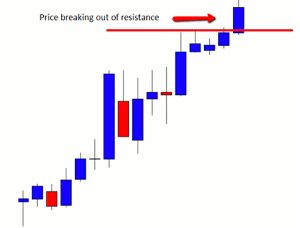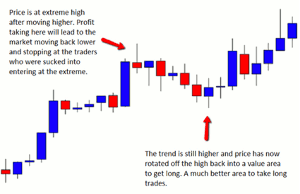The risk in entering a trade after the market has made a large move, is that traders who have made money from the move will start taking profit, and an inexperienced trader can be left holding the bag, notes Johnathon Fox on DailyForex.com.
A lot of traders understand that price action trading is the art of looking at raw chart of a forex pair, stock, or instrument and using only the raw price data to decipher order flow from which they can spot high probability patterns that repeat themselves time again in the markets.
By learning these patterns and order flow clues, traders can position themselves in the correct way to profit from the next move in price.
Whilst many people cover the best setups and patterns to look for, what can at times be even more helpful is knowing what patterns to avoid or when the order flow signals given through the price action are sucking the trader in! A common term to explain traders being sucked into trading is “the false break.” Whilst trading the false break can be a super high probability trade for the price action trader that is doing the sucking in, the trader being sucked in can be in for pain.
In this article we are going to look at two really common sucker trades that traders need to avoid. These apply to not only price action trading, but many other types of technical analysis trading.
The False Break
The false break is a pattern that can be very profitable for the trader who is patient, but for the trader who jumps the gun or doesn’t wait for confirmation, it can be a sucker trade. The false break is easy to spot and is basically noted by price moving through a level before snapping back the other way.
The false break moves often happen at key levels of support or resistance. The traders who enter when price is breaking out can be sucked in and then stopped out as price whips back the other way. For the trader who is patient, he can watch price snapping back and use it to trade in the opposite direction to the break out.
Below I have attached two charts. The first chart shows price starting to break out higher through resistance. Upon noticing this, the break out traders would start to take long trades.
The second chart shows price snapping back lower, which would stop the breakout trader. This is also when the trader who has been patient could use this false break signal to take a short trade and use the false break in their favour, rather than being sucked in like the breakout trader.
Entering From Extreme Highs and Lows
When traders come to forex, they have a strong urge to trade from the extreme highs and lows. The main reason for this is these new traders hear the saying “The trend is your friend” and they try to implement it into their trading. Because they normally lack a solid education, the new trader does not understand how to enter high probability trades with the trend.
The risk of entering trades after the market has made a large move is that the people who have made money from the large move will begin to take profit. This can lead to the market turning back the other way. As the new trader starts entering the market at the extreme high or low, the professionals are taking profit and leaving the market, which will cause price to change directions against the new trader’s positions.
The chart below highlights how this pattern works and how it leads many traders to being sucked in. On the chart, you can see the price has made a large move higher. From this move higher, a lot of traders would have made solid profits. The high of this market is where a lot of traders will enter trying to trade with the trend. As we said above, the worry is that the traders who are holding profit can take profit at this high, which will cause price to move lower and stop the new trader out.
The best way to enter high probability trades with the trend is to wait for price to rotate off the extreme high or low back into a value area.
By Johnathon Fox, Contributor, DailyForex.com
























